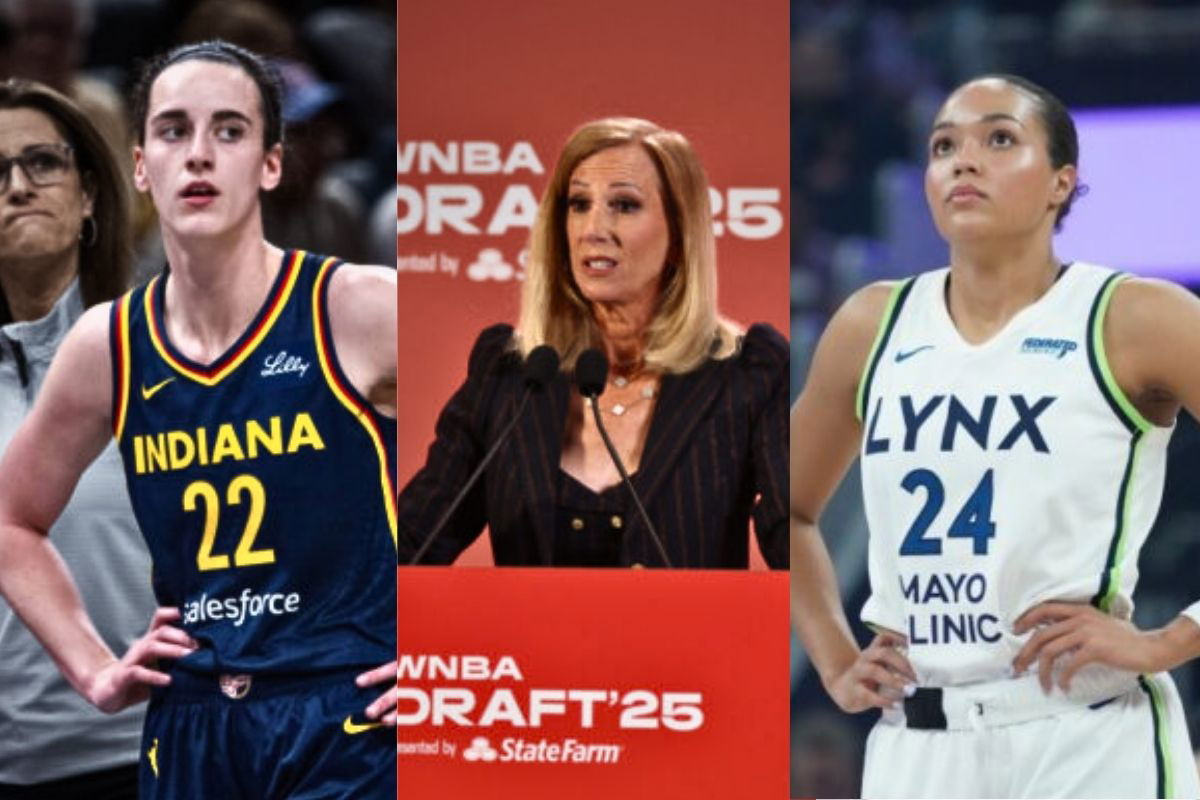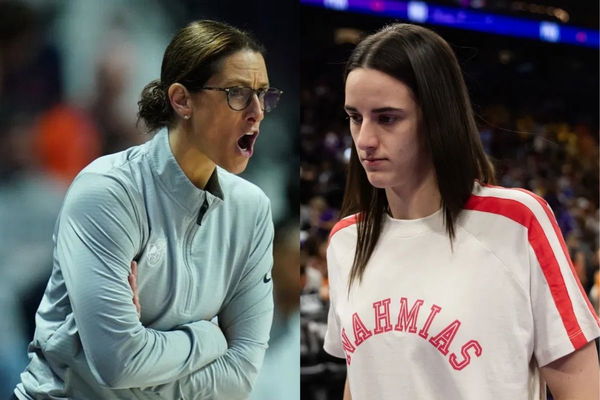

The WNBA CBA negotiations were already going to be a full spectacle. But in her blowout exit interview, Napheesa Collier really ensured that player compensation (among other things, of course) stayed front and clear. Naturally, Caitlin Clark’s name had to come in. And now, even though nobody has forgotten the previous comments, Collier just had to add more to them, keeping the looming deadline in view.
Watch What’s Trending Now!
In an expansive October 27 interview for Glamour’s 2025 Women of the Year issue, Collier joined Satou Sabally, Nyara Sabally, Lexie Hull, and Jonquel Jones, and immediately dove into the thorniest parts of the conversation that’s holding the league at a standstill. “I can talk about whatever I want to talk about,” she told the outlet, standing by every word from her September exit interview that sparked this debate in the first place. And then emphasized how the players are being cheated by giving the example of Caitlin Clark, yet again.
“We are being so grossly almost taken advantage of, and it should be illegal,” Collier tells me of the current deal, which caps a maximum base salary for a player around $250,000—a number reserved for a small group of longtime vets. The amount of money that Caitlin Clark has made the league is insane, and she’s getting 0% of it because we have no rev share,” Collier said. “She gets less than $80,000 a year, and she’s bringing in, like, hundreds of millions of dollars. It’s insane.”
ADVERTISEMENT
Ryan Brewer, a finance professor at Indiana University Columbus and a valuation specialist, explained that Clark’s presence was responsible for more than 25% of the WNBA’s revenue in her rookie year without getting a cut from that. Shocking but still a reality, less than 1% of CC’s total income comes from her WNBA salary, as her million-dollar brand deal carries a heavy load. However, Clark and other players could have received a piece according to the current CBA.
Let me explain. The current CBA from 2020 does have a revenue-sharing provision that could give players 17.5 % of surplus revenue. In case you’re wondering, surplus is the amount the league set some revenue targets, which are cumulative, while signing the CBA (20%). If the revenue goes beyond the target, the excess money is shared with the players. However, the surplus rate has never been achieved.
But Collier has made all these points before, back in Minnesota’s exit interviews on September 30. In around four minutes, she laid bare exactly how the system feels for the players. Her remarks now are based on what she had alleged before, that WNBA commissioner Cathy Engelbert told her Clark “should be grateful” for earning $16 million off the court, suggesting she wouldn’t have been able to do so without the WNBA’s platform.
ADVERTISEMENT
That comment didn’t sit well with players, and the tension only grew after NBA commissioner Adam Silver weighed in. Appearing on NBC’s Today show on October 21, Silver was asked whether WNBA players should receive a larger piece of league revenue, given that they currently get around nine percent compared to NBA players’ fifty. “Yes,” he said, “but I think ‘share’ isn’t the right way to look at it… You should look at it in absolute numbers.”
The WNBPA clipped Silver’s line, “Share isn’t the right way to look at it,” and posted it to Instagram with the caption, “Don’t want to share?” The union’s executive director, Terri Jackson, followed up days later, accusing the league of offering “bad math” and a “piece of a piece of the pie” while paying itself back first. It was a direct shot not only at Engelbert’s approach but also at Silver’s framing, which players saw as dismissive of their fight for a fairer system.
ADVERTISEMENT
In response, the WNBA issued a statement to ESPN insisting that its new proposal already includes an uncapped revenue-sharing model directly tied to performance and that it was “incorrect and surprising” for the union to claim otherwise. Still, Collier and the WNBPA remained firm, saying that whatever’s on paper doesn’t match what players actually take home. For them, Silver’s comments symbolized a larger disconnect between those running the league and those keeping it alive on the court.
But now, for the upcoming CBA, the league has included increased salaries and a similar provision. However, reportedly, the targets are more lenient than the last CBA. Even with lenient targets, the pie is shrunk further if we refer to the current CBA. The only revenue that could be shared is the small increment beyond the target. Whatever that hypothetical amount might be, 30% is slashed as “the cost of revenue.”
The remaining 70 percent is considered the “shared revenue” and is split equally between the players and the league. All in all, the players will get crumbs even with the improved CBA, which is why Collier and Co. are standing firm on their revenue share demand.
ADVERTISEMENT
It’s not just Collier who feels this way. Fever guard Lexie Hull told Glamour that she earns “double to triple” more by playing in Unrivaled, and that much of her actual income comes from endorsements. While the average WNBA salary sits around $150,000, Front Office Sports notes that Unrivaled averages roughly $220,000.
The talks are still stalled as the two parties have reportedly agreed to extend the deadline beyond October 31. However, there is little reason to fear a lockout as the 2026 season can still start on time. That is especially critical for the Indiana Fever and Caitlin Clark, considering her injury-ridden 2025 season.
ADVERTISEMENT
Caitlin Clark’s 2026 Comeback Still on Track Amid Uncertainty
Caitlin Clark couldn’t compete in more than 13 games this past season, suffering multiple soft tissue injuries. Her comeback in 2026 is one of the most anticipated storylines in the world of US sports. She is ramping up her work in the offseason. According to Stephanie White, they can “do some 3-on-3, doing some 2-on-2, building into 5-on-5.” However, she stressed being patient with the injury, saying:

Imago
Image Credits: IMAGN
“She needs to be able to slowly build back so that from an endurance standpoint, she’s laying a really good foundation so that we’re not having any setbacks or any regression,” White further added. So it seems she is on track for a thumping return next season, which is still months away. However, the CBA situation has threatened a delay or complete cancellation of next season.
The WNBA offseason checklist is filled, and none of it can be achieved without an agreed CBA. With two new teams in Toronto Tempo and Portland Fire, the league will have an expansion draft. Then there is the biggest free agency this league has ever seen, with approximately 80% of the league signing new contracts.
Then there is the 2026 draft. The longer this drags on, the more this schedule gets cramped with a possibility of delaying the 2026 season or worse, canceling it outright. That gives Collier, Engelbert, and Silver 5 months to agree on a deal and still get a relatively normal season. It will be great if each task were given time to be organized.
ADVERTISEMENT
ADVERTISEMENT
ADVERTISEMENT

